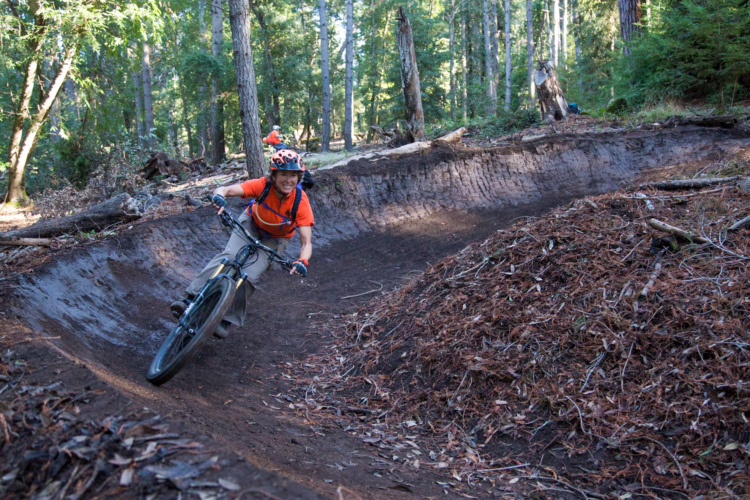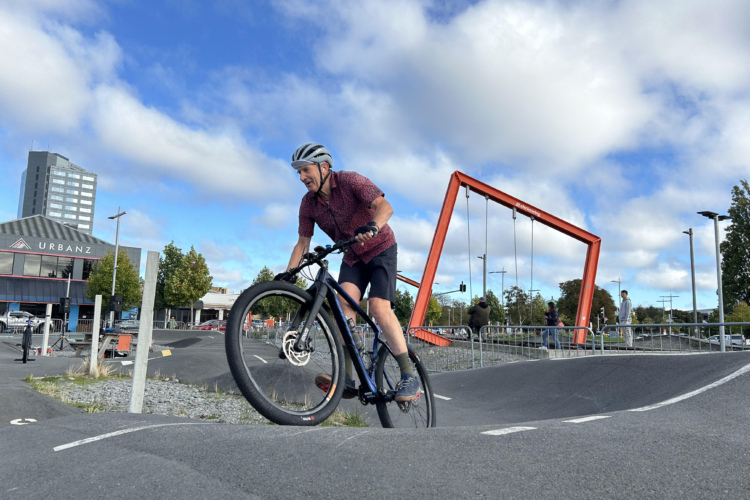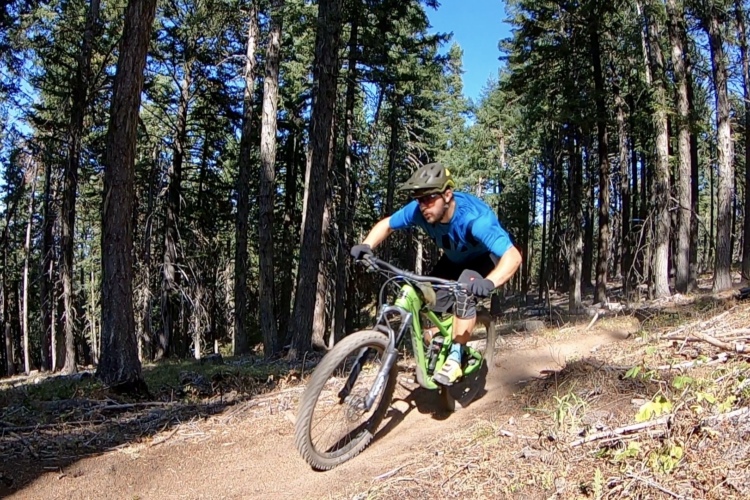
The Knolly Fugitive 140 is the brand’s mid-travel trail ripper, designed for flow trails and black-diamond tech alike. It’s not quite an enduro bike, but it should be enough bike to get you out of trouble in most scenarios. More pedal-friendly than a Chilcotin, burlier and more stable than an Endorphin, the Fugitive is Knolly’s answer to the quintessential quiver-killing trail bike. This isn’t the first iteration of the Fugitive, and we’ve seen some changes here with the latest generation that should make it easier to live with.
In this review

What’s New on the Gen 6 Fugitive?
Knolly says their Gen 6 bikes incorporate everything the company has learned so far, to create their most refined models yet. The updated Fugitive follows this trend, and one of the most noticeable changes in the sixth generation Fugitive is the straight top tube, which aligns with modern bike design trends by offering a cleaner look and a lower standover height.
Another key improvement is the mono block rocker link, now machined from a single piece of aluminum, which increases frame stiffness and reduces lateral stress on the shock, potentially extending the lifespan of both the shock and bearings. In addition, and perhaps most importantly, the upper linkage now uses Enduro bearings instead of bushings, providing smoother and more reliable long-term performance. Gen 6 Fugitive frames all also use the SRAM UDH hanger mount, and Knolly says they’ve also increased dropper insertion, fitting a minimum of 200mm on most frame sizes.
Knolly Fugitive 140 Gen 6 Key Specs
- 150/140mm travel front/rear
- Four colors: Raw, Anodized Bronze, Dad Jeans Blue, Chameleon Purple
- Geometry highlights: 64.75º HTA, 76.75º STA, 430mm-442mm size-specific chainstays
- 29″ wheels and SRAM UDH hanger
- Super Boost rear hub spacing and long-travel dropper compatible
- Tool mount under top tube
- Sizes S – XL
- Weight: 34.2lb as tested
- Price: $4,599-$5,899 complete, $2,599-$2,799 frame-only
- Buy directly from Knolly or through a local Knolly dealer
Frame features
The Knolly Fugitive Gen 6 sees a slight increase in rear wheel travel, moving from 138mm to 140mm, along with the addition of a shorter 125mm travel option. However, its core purpose remains the same. Rolling on 29” wheels front and rear, it’s Knolly’s versatile mid-travel all-mountain bike.
The alloy frame still has Super Boost rear hub spacing, a threaded bottom bracket with removable ISCG mounts, and a 44/56mm press-in headset. Riders can also adjust the geometry with a two-position flip chip at the bottom of the shock mount, and the Fugitive still uses Knolly’s Four-By-Four suspension design. Cabling is internal and looks relatively tidy; since the frame is aluminum there’s no tube-in-tube routing, which means it can be set up for brake hoses to come out of either side of the headset, for those who prefer to run their controls moto style.


While there’s no in-frame storage, Knolly includes both a bottle cage mount and a tool mount inside the front triangle.
The aluminum-alloy Knolly Fugitive comes in four frame sizes, small through extra large, in four colors. It’s available in four spec levels, and as a frame-only. I’ve been testing a size large bike with 140mm of rear travel, with GX spec, in blue. Pricing starts at $4,600 USD for the Deore build, and ends at $5,899 for the XT spec, with frames priced at $2,599, and $2,899 for a Float X Performance Elite, or Factory Shock, respectively.

I like the change from linkage bushings to cartridge bearings, especially since I noticed an issue with the bushings in my review of the last gen Knolly Chilcotin. The straight top tube is a minor change, but makes a big difference to the way the bike looks, and overall the frame is more modern in terms of spec. I did find, however, that the placement of the bottle cage and tool mounts are a little tight. The bottle cage mounts are quite high up the frame, meaning I can only fit a small bottle in a size large frame, and having a full-size tube strapped to the tool mount makes including any bottle impossible. I like the inclusion of the tool mount, but it seems to me that there’s room to move these to make life a little easier.


Geometry
The Gen 6 Fugitive sees updates across the board in terms of geometry. The head angle has been slackened slightly by 0.25º to 65.5/64.75º on the 140mm model, while reach has increased by 7mm to 492mm on the size large. The seat angle remains close to the previous version at 76.75º/76º, slightly slacker than the Knolly Chilcotin, reflecting the Fugitive’s versatile riding intent — up, down, and across terrain, rather than just climbing. A more notable change is the introduction of size-specific chainstays, starting at 430mm for the small frame and extending to 442mm on the XL.

Suspension
The Fugitive is built around Knolly’s Four By Four suspension design, with a focus on traction, and sees some refinements in this latest version. Knolly says that pedaling efficiency has improved by 15%, making the Gen 6 Fugitive easier to climb, particularly when standing and applying more force. Additionally, Knolly has adjusted the leverage curve to enhance sensitivity and bottom-out resistance, while making it easier for the bike to settle into its mid-stroke. This should compliment the improved pedaling responsiveness, ensuring solid traction in the mid-stroke while feeling more supportive overall.



Components
The GX build I tested is priced at $5,199 and tips the scales at 34.2lbs with a Fox 36 Performance Elite fork and Float X shock. These components are well reviewed enough, and while I’m not personally a huge fan of the Fox Float X, the fork and shock work well together and are a solid build package for most riders.
Every Knolly Fugitive 140 build comes with either DT Swiss M1900 Spline wheels or Spank 359 wheels. My test bike has the DT Swiss wheels, and honestly, they’re some of the best value wheels out there. The rims are as sturdy as alloy rims come, and the DT Swiss 370 hubs, while low engagement, are practically bombproof. Every build also gets the same Maxxis EXO+ Maxxgrip Assegai tire up front, and Maxxterra Minion DHR II tire out back.
The GX build comes with, you guessed it, a SRAM GX Eagle mechanical drivetrain. While it’s not fancy, it’s a workhorse drivetrain that I’ve put a lot of miles on over the years, and if nothing else, it delivers dependable performance. The finishing kit features Race Face Aeffect aluminum parts, and an SDG Tellis dropper post.
Performing stopping duties are Magura MT5 four-piston brakes on 203/180mm rotors, which seem like they should provide ample stopping power. However, that turned out not to be the case. More on that later.

Climbing
Knolly talks about their Four By Four suspension platform a lot, and how it focuses on traction over things like anti-squat to deliver grip while climbing and descending. I will say that the Fugitive makes good on the promise of eschewing high anti-squat numbers, because it certainly is quite active while climbing. I wound up setting the sag at around 30% to get a somewhat plush yet efficient ride, but found that the level of pedal-bob was on the generous side of things, and as a result the bike felt sluggish on the climbs. Turning the climb switch on helps on smooth road climbs, but is not something I like to do on technical climbs.
While favoring grip over anti-squat makes sense in theory, I didn’t feel like this works out in practice, because it doesn’t feel like it results in greater levels of traction than say a VPP bike, which tends to have high levels of anti-squat and also climbs fairly well.
Geometry-wise however, the bike feels pretty adept, and even in the low geo setting, I didn’t find myself getting too many pedal strikes. It did feel like my weight was pushed a little too far forward, no doubt due to the lengthy 492mm reach coupled with a somewhat old-school 50mm stem. A shorter, more modern stem would put the rider in a better climbing and descending position in my opinion.

Descending
Thankfully, the Knolly Fugitive descends better than it climbs. The suspension feels extremely supple, and on the way back down I can feel it doing what Knolly describes in terms of grip and plushness. I kept the bike in the high geometry position for my first couple of rides and found that it felt a little unsettled and nervous in terms of handling. After dropping the Fugitive into slack mode, things started to click. Dropping 0.75º off the head angle and lowering the BB by 10mm, the Fugitive suddenly felt more planted, without taking much of a hit in the climbing department.
The suspension does tend to sit pretty firmly in the middle of its travel, which helps the bike feel quite supple. The beginning and mid-stroke feel very plush, and it makes for a very smooth ride, especially over rough ground, with great small-bump sensitivity, and little in the way of pedal kickback, which makes it great for pushing through rough sections of trail. There’s decent bottom-out resistance, and while I rarely felt the bike bottom out, I did feel like it lacked the type of support a harder charging rider might look for.

The geometry and travel numbers lend themselves to a fairly stable bike that’s also fun and playful. The short chainstays make for excellent cornering manners, and the short travel and relatively light weight make the bike fairly easy to place where you want it. And the plush suspension makes it feel quite forgiving. Personally, it’s not quite the bike for me; I tend to prefer something that prioritizes support over a bottomless feeling.
All of the components on the bike held up well through testing, with the exception of the brakes. I tried to give them a chance, but from the get-go, the front brake would not bed in, despite multiple attempts to resurface and bed in with a brake-bedding machine. The pads wound up glazed and the brake was ineffective every time. I wound up swapping my Hope Tech 4 V4 front brake on for the duration of the test to achieve any sort of braking power. Despite what felt like ‘normal’ operation on the rear brake, it still felt under-powered, meaning I couldn’t quite unlock the full potential of the bike since I was holding back a little most of the time.
Pros and cons of the Knolly Fugitive 140
Pros
- Fits long-travel droppers
- Pivots now use bearings throughout
- Plush/supple suspension
- Decent spec package for the money
Cons
- Climbs like an enduro bike, descends like a trail bike
- Not as refined as other high-performance trail bikes
- Front triangle lacks proper room for bottle and tool mount
- Magura brakes are hard to set up and lack power

Bottom line
When it comes to mountain bikes, there are certain horses for certain courses, and this horse is probably better suited for a rider who wants a very plush and forgiving ride feel, and doesn’t mind how it climbs. It’s perhaps suited to a more novice/intermediate rider who could use the confidence that comes with a supple suspension feel and doesn’t need ultra-powerful brakes.
These days the trail bike market is pretty crowded, and brands need refined designs and builds to stand out. That means the bar is also pretty high, with the best bikes delivering incredible performance both uphill and down. While the Knolly Fugitive 140 looks good on paper, it falls shy of the mark for me.





















10 Comments
Oct 29, 2024
Oct 30, 2024
Oct 30, 2024
Jan 1, 2025
Nov 4, 2024
Descending I’m also confused as to how he didn’t feel enough support. Granted, I’m in the 27-28% sag range, but at 235lbs I don’t even think I’ve bottomed the thing out yet. It grips like crazy while not feeling stuck down like a coil sprung enduro bike. I will say, it took a bit of fiddling especially with LSC to get it feeling perfect. Not necessarily a con, but it does feel very sensitive to LSC changes.
The geo is also excellent. Coming from a shorter bike it took me a second to get used to the longer reach, but once I did I don’t think I could go back. Being able to just lean forward and know you’re gonna hook up feels great.
Oct 30, 2024
Knolly seems to be one of those brands that some people just love while others are left scratching their heads. I can't see buying one blind unless they have some kind of incredible sale in their frames. It will be interesting to see how other reviews play out.
Oct 30, 2024
I typically have a few different bikes in my stable at any one time, giving me a pretty good base for comparison. This was my honest experience, and it would be doing a disservice to myself and to readers to not tell the truth. As much as I wanted to really like the bike, it didn't live up to my expectations. The way a bike rides is highly subjective, and this is just one reviewer's opinion, so please do take it with a pinch of salt, knowing that we all experience things differently.
FYI nowhere does Knolly's website have recommended sag - 30% is typically where most manufacturers suggest you start, unless stated otherwise (the We Are One Arrival I tested a couple years ago is recommended to run at 20% sag, and is explicitly stated so, since it's quite unusual).
Anyways, I appreciate your comment - I'm always open to constructive criticism, however I do stand behind my words on this one. There is a lot to like about the Fugitive, but as you alluded to, it's just not the bike for me - I feel like I did point at that toward the end of the article.
Cheers
Oct 30, 2024
Oct 30, 2024
Oct 31, 2024